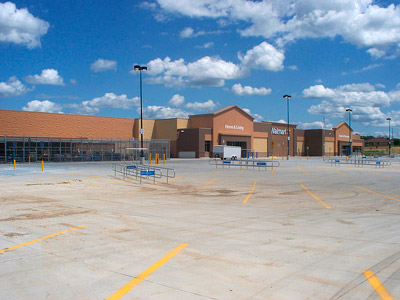
(Photograph located at Grist.com at: http://grist.org/business-technology/2011-11-29-can-you-say-sprawl-walmarts-biggest-climate-impact-goes-ignored/
It is certain that many big box stores will soon be fading
from the urban landscape, after being a fixture along arterials for decades. In some areas, this has already started.
In the aftermath of their departure from arterials, there
will be large areas of vacant land, unless local governments take the initiative to
investigate alternatives for reuse of these areas. In addition,
the departure of big box stores mean unemployed residents, reduce sales and
property and negative symbols for the community.Therefore, this should be a priority for local governments.
The following are some suggestions for strategies of reuse
of the vacated land. :
1. Use them for public facilities.
With many local governments strapped for funding to build new facilities, there is an opportunity to transform these areas for public uses. They could also be reused for indoor recreation facilities such as ice rinks, indoor tracks, public libraries and community recreation centers.. Their use as museums, auditoriums, schools, adult education centers and parks could also be considered. The latter suggestion of conversion to parks would require partial or complete reconstruction of a site.
2. Convert them into incubators for start-up small businesses and light industry
Many start-up small businesses and light industries have the need for facilities with low rent so that they can start production for innovative products. The big box stores should be very appropriate for this with flexible space, loading zones, parking, outdoor storage possibilities and access to an arterial. .
3. Rezone them for mixed-use developments or Planned Unit Developments.
The concept of planned unit developments (P.U.D’s)-an individually planned development which is a overlay zone over the existing zoning- has a long history of success in creating areas with a mix of commercial, industrial, institutional and residential area. The problem with these big box stores is that they have been a visual blight to the urban strip arterial. P.U.D’s realize the opportunity for creating an area that will be an improvement over the existing facilities with appropriate landscaping, traffic control and other elements that will make the arterial shopping strip more attractive.
The impending departure of big box stores does not have to be a problem, but an opportunity. Arterial shopping strips have often been an eye sore in many communities, which big box stores contributed. With a move toward urban development that is oriented toward: public transportation, mixed uses, neighborhood oriented, pedestrian friendly and sustainability, this may be the needed impetus to address the design and future of arterial shopping strips. As referred in an earlier blog entry, this needs to part of a cooperative and relational based planning process.
If some of my readers have further suggestions, please leave your comments below. All comments will
be reviewed and posted if appropriate.
In an upcoming blog entry, I will provide online references for further exploration of this issue by those interested.
The author of this blog entry, Dr. Michael A. McAdams, is an independent consultant specializing in urban planning, spatial technologies and transportation planning. He can be reached at michaelamcadams@yahoo.com .

No comments:
Post a Comment